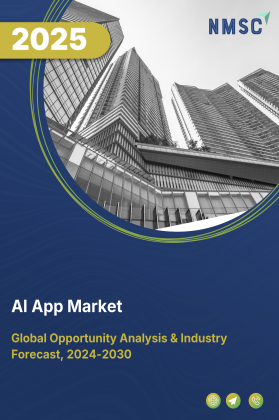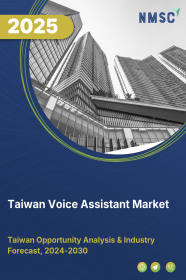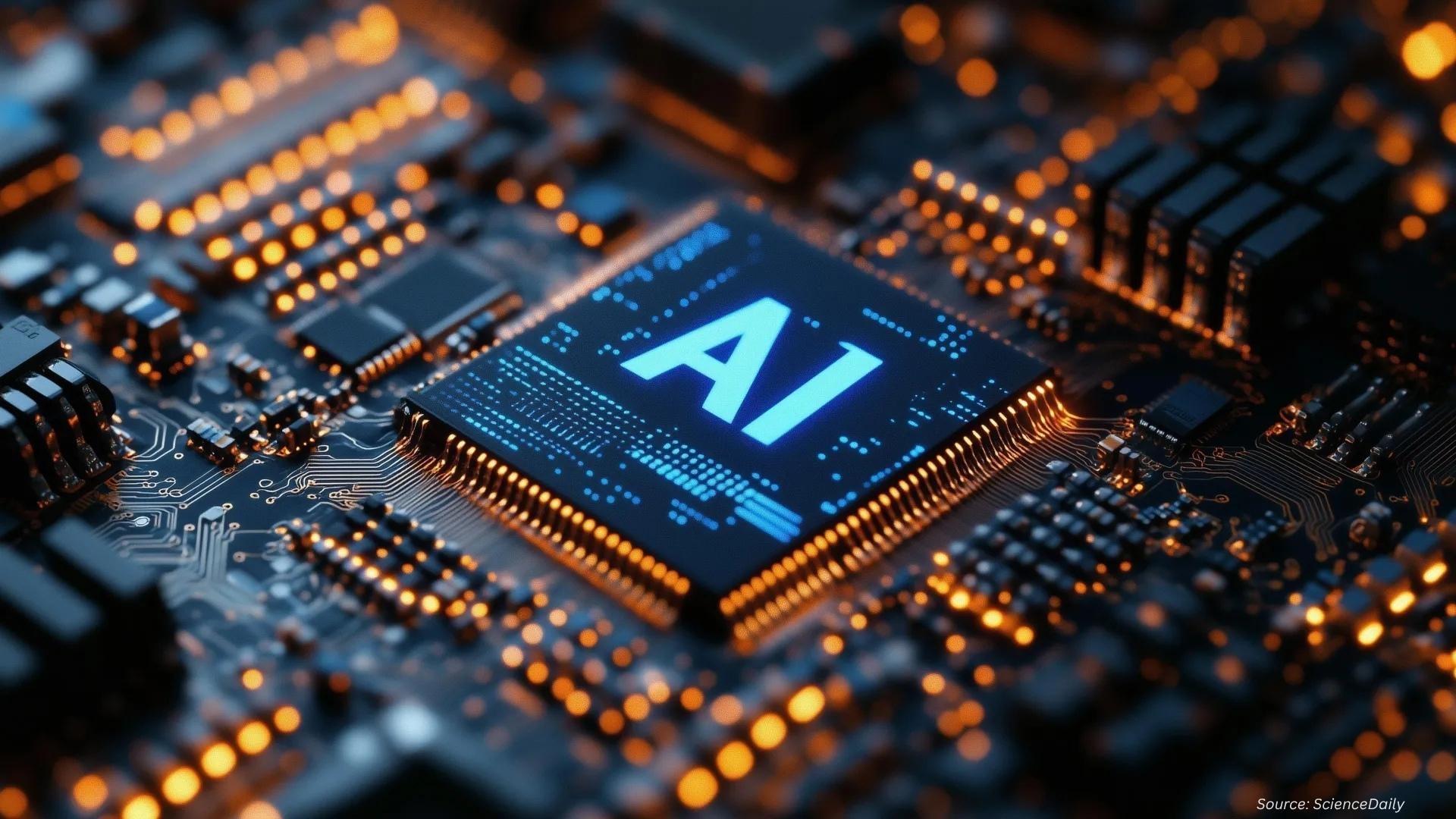
AI App Market by Component (Software, Services), by Deployment (Cloud-Based, On-Premises), by Technology (Computer Vision, Predictive Analytics/Machine Learning, Others), by Application (Customer Service Solutions, Content Generation Tools, Risk Management Systems, Process Automation, Sales & Marketing Tools, Productivity Assistants, and Computer Vision Applications), by End-User (IT, BFSI, Others) – Global Opportunity Analysis and Industry Forecast, 2025 – 2030
Industry Overview
The global AI App Market size was valued at USD 4.23 billion in 2024, with an estimation of USD 6.22 billion in 2025 and is predicted to reach USD 42.72 billion by 2030 with a CAGR of 47.0% from 2025-2030. The market is witnessing strong growth, driven by rising demand for automation, workforce productivity, and digital transformation.
With software developer employment projected to grow by 17.9% between 2023 and 2033, and 68% of the global population using the internet in 2024, adoption of AI apps is accelerating across sectors. The widespread use of virtual assistants, present in 85% of smartphones, further fuels user familiarity and integration.
However, escalating cyber risks, with 72% of cyber leaders citing growing threats, and stringent data regulations pose significant restraints. Still, high-growth opportunities lie in sector-specific AI solutions, especially in economies like India, where AI could contribute up to USD 500 billion across agriculture, healthcare, and urban planning.
Rising Automation and Workforce Productivity Drives the Market Growth
A major driver of the AI app market demand is the growing demand for automation and workforce productivity, closely aligned with the rapid expansion of the software development sector. According to projections by the U.S. Bureau of Labor Statistics (BLS) in 2025, employment of software developers is expected to grow by 17.9% between 2023 and 2033, significantly outpacing the average growth rate of 4.0% across all occupations.
This surge reflects the increasing reliance on digital solutions, including AI-powered applications, to optimize business operations. As organizations continue to adopt AI tools for automating routine tasks, enhancing decision-making, and improving employee efficiency, the market for AI applications is poised for sustained growth. The acceleration of hybrid work environments and the need for scalable, intelligent software solutions further amplify this trend.
Rising Internet Penetration and Smartphone Usage Drives AI App Adoption
The growing penetration of smartphones and internet connectivity is a significant driver of the AI app market growth. According to the World Bank, approximately 68% of the global population used the internet in 2024, reflecting a substantial rise in digital access across both developed and developing regions.
This expanding online population fuels the demand for AI-powered apps that enhance daily tasks, ranging from voice assistants and personalized recommendations to real-time language translation and smart shopping tools. As smartphones continue to be the primary gateway to these digital services, the increased connectivity enables more users to access and benefit from AI-driven applications, driving market growth on a global scale.
Widespread Use of Virtual Assistants Accelerates the Market Growth
The growing popularity and widespread availability of virtual assistants are key drivers of the market. According to the U.S. National Library of Medicine (NLM), as of 2025, approximately 85% of smartphones are equipped with virtual assistant capabilities, highlighting their deep integration into everyday digital devices.
Additionally, about 44% of users actively engage with virtual assistants across platforms such as Google Assistant, Siri, Alexa, and Cortana. This increasing comfort with conversational AI is fuelling demand for AI-driven apps that offer voice interaction, personalized support, and smart task management.
As consumers adopt these assistants across phones, smart speakers, and other devices, developers and businesses are expanding the use of similar AI capabilities across productivity, lifestyle, customer service, and enterprise apps, further propelling market growth.
Escalating Data Security Risks Limits AI App Adoption
Rising data security concerns are emerging as a significant restraint on the market. According to the World Economic Forum in 2025, 72% of cyber leaders report that cyber risks are increasing, highlighting growing vulnerabilities in digital systems. AI apps, which often rely on collecting and processing sensitive user data, are particularly exposed to threats such as data breaches, unauthorized access, and algorithmic misuse.
These risks not only undermine user trust but also complicate regulatory compliance under stringent data protection laws like GDPR, CCPA, and India’s Digital Personal Data Protection Act. As a result, businesses and consumers are increasingly cautious in adopting AI applications, particularly in sectors handling critical or confidential information, thereby slowing broader market adoption.
Sector-Specific AI App Unlocks High-Growth Opportunities
The growing demand for industry-specific AI solutions presents a major growth opportunity in the market, particularly in emerging economies like India. According to the World Economic Forum in 2025, AI has the potential to contribute up to USD 500 billion to India’s economy, with transformative impact expected across sectors such as agriculture, healthcare, and urban planning.
This highlights a strong need for customized AI applications tailored to the operational challenges of each industry, such as AI-powered crop monitoring in agriculture, diagnostic support tools in healthcare, and intelligent infrastructure management in urban development. By focusing on sector-specific use cases, AI developers and businesses can unlock new growth avenues, drive digital transformation, and deliver high-impact, localized solutions that support both economic development and technological innovation.
Market Segmentations and Scope of the Study
The AI app market report is segmented on the basis of component, deployment, business model, developer platform/ecosystem, technology, application, end-user, and regions. On the basis of component, the market is divided into software and services, with services further segmented into consulting & integration, maintenance & support, and custom app development. On the basis of deployment, the market is categorized into cloud-based, on-premises, and hybrid models. Based on business model, the market is classified into B2C, B2B, and B2B2C segments. On the basis of developer platform/ecosystem, the market is segmented into no-code/low-code platforms and pro-code SDKs/frameworks. By technology, the market is categorized into natural language processing (NLP), computer vision, predictive analytics/machine learning (ML), autonomous agents & robotics, and others. On the basis of application, the market is segmented into customer service solutions, content generation tools, risk management systems, process automation,RoW).
Geographical Analysis
The strong presence and continued growth of leading technology companies such as IBM, Microsoft, Google, Amazon, and NVIDIA in North America serve as a significant driver of the AI app market share. These firms are at the forefront of AI innovation, developing advanced platforms, tools, and cloud-based services that power a broad range of applications.
For instance, Microsoft’s AI-driven growth has been particularly notable, Azure revenue surged by 39% year-over-year in 2025, surpassing USD 75 billion, and the company briefly reached a USD 4 trillion market cap, largely driven by the success of its AI-powered cloud and Copilot offerings.
Such performance highlights how enterprise-grade AI solutions are being rapidly adopted, enabling businesses to scale AI implementation with greater ease. The continuous investments, strategic partnerships, and AI-focused offerings from these tech giants are accelerating digital transformation across industries and reinforcing North America’s role as a global hub for AI app development and deployment.
One of the key drivers of the market in Europe is the region’s regulatory leadership in promoting ethical, transparent, and human-centric AI. According to the European Parliament, the EU AI Act, the world’s first comprehensive legal framework for artificial intelligence, officially entered into force in August 2024, with its first compliance milestones taking effect on February, 2025. These initial rules ban AI systems deemed to pose unacceptable risks and mandate new standards for transparency and governance.
This regulatory clarity is prompting businesses to develop and adopt AI applications that are compliant, secure, and socially responsible. As a result, sectors such as healthcare, finance, manufacturing, and government are increasingly investing in AI tools aligned with these standards, driving demand for trustworthy and scalable AI applications across European markets.
Digital transformation continues to be a powerful driver of the AI applications market in the Asia-Pacific region, particularly in countries like India, China, Japan, and South Korea. According to the International Trade Administration (ITA) in 2024, India alone had over 650 million smartphone users and more than 950 million internet subscribers as of mid-2024, reflecting a thriving digital ecosystem powered by a young, tech-savvy population. This surge in digital connectivity is driving the need for AI-powered solutions across sectors such as e-governance, finance, healthcare, logistics, and education.
National initiatives like Digital India and China’s Smart City programs are further fuelling AI adoption by promoting automation, real-time analytics, and improved service delivery. As businesses and governments embrace cloud, IoT, and mobile platforms, demand for scalable AI applications is expanding rapidly across the region.
The emergence of vibrant startup ecosystems in regions like Latin America, Southeast Asia, and Africa is becoming a key driver of market growth. Local tech hubs, accelerators, and incubators are fostering a new generation of entrepreneurs focused on AI-driven innovation tailored to regional challenges. These startups are developing apps for sectors like agri-tech, edtech, healthcare, and microfinance, often using AI to address access gaps and inefficiencies.
Supported by international investments, cross-border collaborations, and local talent pools, these ecosystems are helping accelerate the development and adoption of AI apps that are cost-effective, scalable, and relevant to underserved populations. This grassroots innovation is expanding the market and deepening AI’s impact in RoW regions.
Strategic Analysis Adopted by Key Players
Key players in the AI app industry are actively enhancing their technological capabilities and product offerings through the launch of advanced generative models, standalone AI applications, and enterprise-grade solutions.
-
In April 2025, Meta officially launched its standalone Meta AI assistant app, powered by Llama 4, featuring voice interaction, a social “Discover” feed, and integrations across Facebook, Instagram, WhatsApp, and Ray‑Ban smart glasses.
-
In January 2025, Alibaba Cloud released its Qwen 2.5 AI model series (including Qwen 2.5‑VL and Qwen 2.5‑Max), claiming it surpasses DeepSeek‑V3 and matches or exceeds GPT‑4 benchmarks.
-
In November 2024, NVIDIA introduced Fugatto, its multimodal generative AI model for creating or transforming music, voices, and sounds via text and audio prompts.
-
In April 2024, Cohere launched Command R+, an enterprise‑grade LLM optimized for real‑world business workflows, first on Microsoft Azure and subsequently through platforms like Amazon Bedrock.
-
In April 2024, Google launched Google Vids, a Gemini-powered AI-assisted video editing app integrated within Workspace for creating storyboards, voiceovers, and editing content.
Key Benefits
-
The report provides quantitative analysis and estimations of the market from 2024 to 2030, which assists in identifying the prevailing industry opportunities.
-
The study comprises a deep-dive analysis of the current and future AI app market trends to depict prevalent investment pockets in the sector.
-
Information related to key drivers, restraints, and opportunities and their impact on the market is provided in the report.
-
Competitive analysis of the players, along with their market share is provided in the report.
-
SWOT analysis and Porters Five Forces model is elaborated in the study.
-
Value chain analysis in the market study provides a clear picture of roles of stakeholders.
AI App Market Key Segments
By Component
-
Software
-
Services
-
Consulting & Integration
-
Maintenance & Support
-
Custom App Development
-
By Deployment
-
Cloud-Based
-
On-Premises
-
Hybrid
By Business Model
-
B2C
-
B2B
-
B2B2C
By Developer Platform/ Ecosystem
-
No-Code/Low-Code Platforms
-
Pro-Code SDKs/Frameworks.
By Technology
-
NLP
-
Computer Vision
-
Predictive Analytics/ML
-
Autonomous Agents & Robotics
-
Others
By Application
-
Customer Service Solutions
-
Content Generation Tools
-
Risk Management Systems
-
Process Automation
-
Sales & Marketing Tools
-
Productivity Assistants
-
Computer Vision Applications
-
Data Analytics Platforms
-
Others
By End-User
-
IT & Telecommunications
-
BFSI
-
Energy and Utilities
-
Retail & E-commerce
-
Media & Entertainment
-
Automotive
-
Manufacturing
-
Education
-
Healthcare
-
Government
-
Others
By Region
-
North America
-
The U.S.
-
Canada
-
Mexico
-
-
Europe
-
The U.K.
-
Germany
-
France
-
Italy
-
Spain
-
Denmark
-
Netherlands
-
Finland
-
Sweden
-
Norway
-
Russia
-
Rest of Europe
-
-
Asia-Pacific
-
China
-
Japan
-
India
-
South Korea
-
Australia
-
Indonesia
-
Singapore
-
Taiwan
-
Thailand
-
Rest of Asia-Pacific
-
-
Rest of the World (RoW)
-
Latin America
-
Middle East
-
Africa
-
Key Players
-
Google LLC
-
International Business Machines Corp.,
-
Microsoft
-
Amazon Web Services, Inc.
-
Open AI
-
Meta
-
theninehertz.com,
-
Alibaba Cloud
-
Anthropic PBC
-
Cohere
-
Technostacks
-
DataRobot, Inc
-
Classic Informatics
REPORT SCOPE AND SEGMENTATION:
|
Parameters |
Details |
|
Market Size in 2025 |
USD 6.22 Billion |
|
Revenue Forecast in 2030 |
USD 42.72 Billion |
|
Growth Rate |
CAGR of 47.0% 2025 to 2030 |
|
Analysis Period |
2025–2030 |
|
Base Year Considered |
2024 |
|
Forecast Period |
2024–2030 |
|
Market Size Estimation |
Million (USD) |
|
Growth Factors |
|
|
Countries Covered |
28 |
|
Companies Profiled |
15 |
|
Market Share |
Available for 10 companies |
|
Customization Scope |
Free customization (equivalent to up to 80 working hours of analysts) after purchase. Addition or alteration to country, regional, and segment scope. |
|
Pricing and Purchase Options |
Avail customized purchase options to meet your exact research needs. |

















 Speak to Our Analyst
Speak to Our Analyst

























